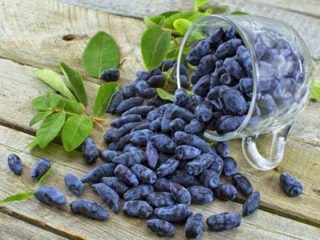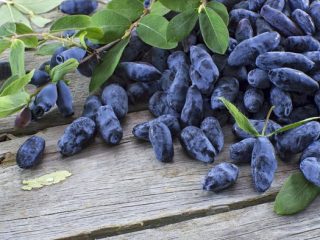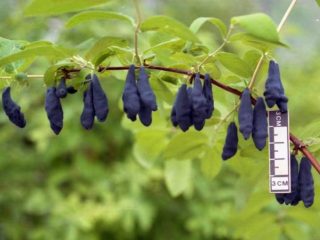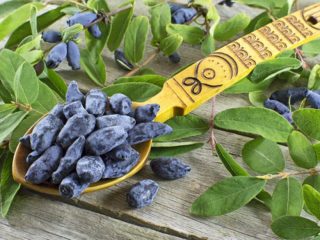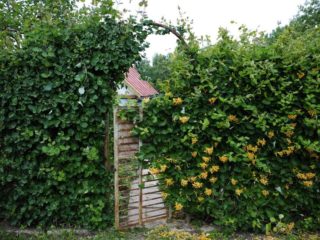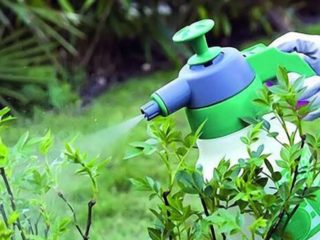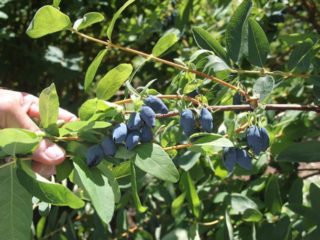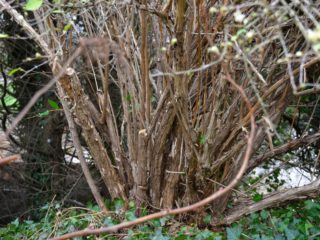Content
Description of the variety, photos and reviews of Long-fruited honeysuckle will be interesting to study for all gardeners who want to grow a beautiful and useful plant. Honeysuckle is quite unpretentious in cultivation, but has its own characteristics.
Benefits of Long-fruited Honeysuckle
The main value of honeysuckle in the garden lies in its fruits. The long-fruited variety is able to please with long berries with a delicate refreshing taste, and the yield of the variety is very good.
The berries are suitable not only for fresh consumption and for preservation. Since they contain a huge amount of vitamins, the fruits are also used in folk medicine. The berries of long-fruited honeysuckle can treat blood vessels, strengthen the immune system and the heart system; honeysuckle is beneficial for digestive diseases.
Description of the long-fruited honeysuckle variety
Honeysuckle of the Long-fruited variety is a medium-spreading shrub; the height of the Long-fruited honeysuckle bush reaches about 1 m.The crown is spherical, formed by a large number of slightly curved shoots. The shoots themselves are thin, green with a slight purple tint and slightly pubescent, and the old branches are covered with brownish-yellow bark.
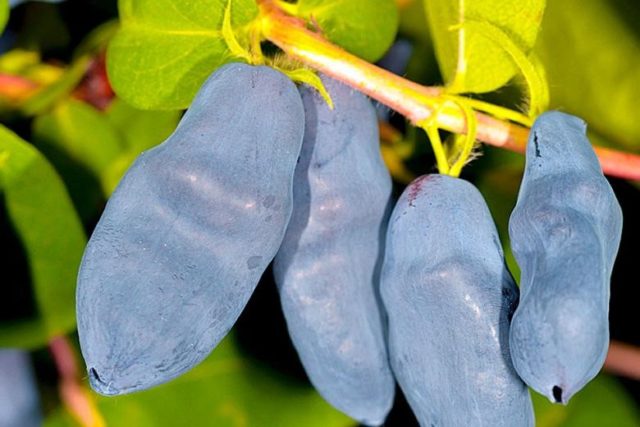
An edible variety of honeysuckle produces very juicy and healthy fruits
The leaves of Long-fruited Honeysuckle are dark green, oblong and lanceolate, soft to the touch and slightly pubescent. The variety blooms with large white-yellow funnel-shaped flowers at the very beginning of May, and the fruits ripen in early June.
The long-fruited variety first bears fruit 2 or 3 years after planting in the ground. As you can easily guess from the name of the variety, the berries of the plant are long, cylindrical in shape, each of them reaches up to 3 cm in length, and the fruits weigh about 2 g. They are covered with a thin, tuberous skin of a dark blue color with a bluish waxy coating, the flesh of the berries is purple - red, juicy and pleasant to the taste, without bitterness. The tasting score of the fruit reaches 4.8 points; the berries can be used both fresh and for preservation.
Planting and caring for long-fruited honeysuckle
Growing honeysuckle in your own area is quite simple. But for this you need to know when to plant the plant in open ground and how to properly care for Long-fruited.
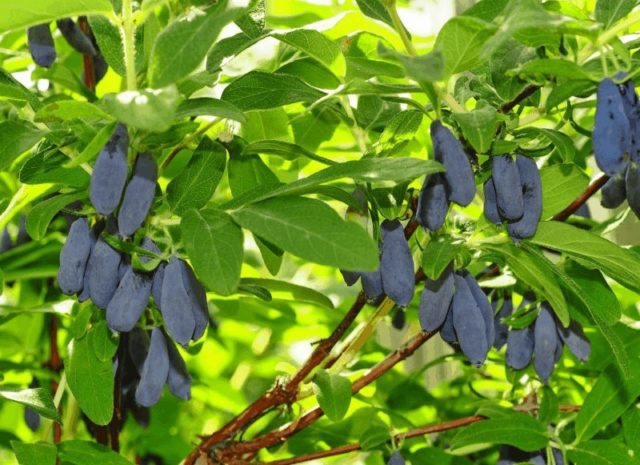
Unlike most plants, Long-fruited honeysuckle requires late planting
Landing dates
The recommended timing for planting Long-fruited trees differs from the standard ones.It is necessary to plant the plant in the ground from the beginning of August to the end of September. This is due to the fact that the fruit bush takes root quite quickly and will have time to take root on the site before the onset of cold weather.
But spring planting of Long-fruited is associated with serious risks. The growing season of honeysuckle begins very early, in early April, and if you plant it during this period, it will develop slowly and with difficulty.
Selection and preparation of a landing site
The characteristics of the long-fruited honeysuckle variety indicate that the plant feels best in open sunny places, protected from strong winds. Therefore, it is recommended to plant shrubs at higher elevations, but not far from tall trees or buildings that will serve as cover from drafts.
To the soil, Long-fruited is undemanding and grows well in poor soil, provided that it is sufficiently loose. The plant does not respond well to waterlogging, so on clay soils it is necessary to provide good drainage.
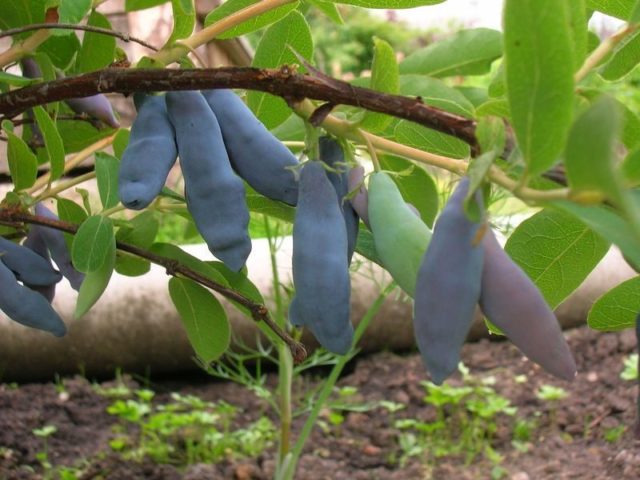
The plant has no special requirements for soil
Before planting, dig a hole for the shrub about 50 cm deep and 60 cm wide. The soil must be mixed with a bucket of rotted manure, 100 g of potassium salt and 100 g of superphosphate added to it.
Landing rules
The planting algorithm for Long-fruited is standard and looks like this:
- one day before planting, the seedling is soaked in a bucket of water, adding growth stimulants if necessary;
- before planting, carefully straighten the roots of the seedling and lower the honeysuckle into a half-filled hole so that the root system is not damaged;
- The seedling is sprinkled with the remaining soil level with the surface, after which a bucket of water is poured under the trunk and mulched in a circle with sawdust.
If the soil at the site of planting Long-fruited is light and aerated, then the plant can be buried about 5 cm, this will promote the growth of the root system. Deepening is not practiced on clay soils, as it leads to rotting of the roots.
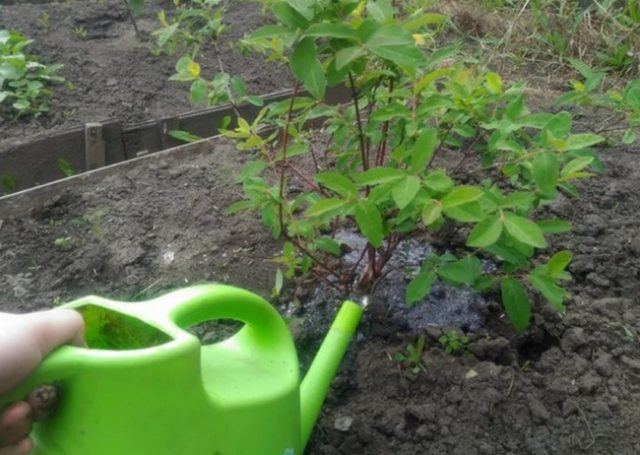
The honeysuckle bush needs to be watered, but so that waterlogging does not occur
Watering and fertilizing
The long-fruited plant has a negative attitude towards waterlogging, but tolerates moderate watering well.
Usually, the bush is watered for the first time in the spring; if the weather is warm and there is almost no precipitation, 1-2 buckets of water are added under the trunk. Wet soil is mulched with humus; it will not only retain moisture, but also serve as a natural nitrogen fertilizer.
The second watering is carried out during bud setting, and the amount of water is increased to 3 buckets. At the same time, you can fertilize with complex mineral fertilizers.
In the summer after fruiting, watering is carried out only as needed. If natural precipitation falls regularly, then the honeysuckle does not need to be watered at all; if there is a drought, then a couple of buckets of water are added weekly under the trunk.
At the beginning of September, the plant is watered for the last time and fed with potassium and phosphorus, and you can also sprinkle the soil with ash. After this, honeysuckle will have enough moisture and nutrients until the next season.
Trimming
A few years after planting, Long-fruited grows and begins to need pruning. The shrub is usually trimmed in the fall after leaf fall, when the honeysuckle goes into a dormant state. During pruning, all dry and broken branches are removed, diseased and old shoots are pruned, and it is also recommended to thin out the crown.
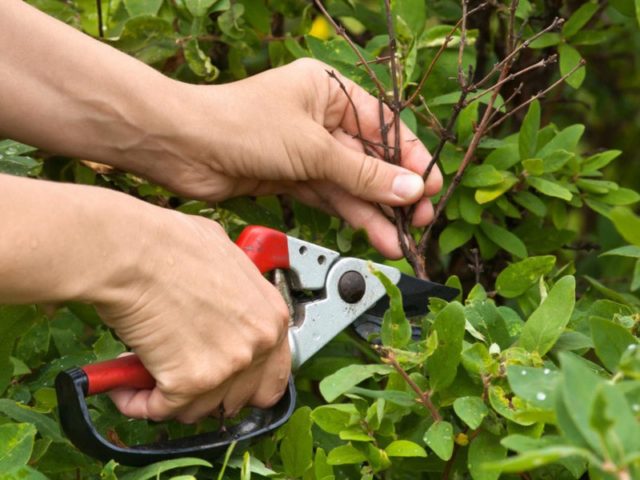
Every year it is recommended to carry out sanitary pruning of bushes
As a result of pruning, honeysuckle receives an incentive to form new young shoots. In addition, the branches of the plant begin to receive more oxygen and sunlight, which ultimately has a positive effect on health and fruiting.
Wintering
Long-fruited honeysuckle tolerates winter cold very well. The plant does not need any special preparation for winter; regular autumn work is sufficient. Namely:
- trim dry and broken branches of the plant;
- remove plant debris from under the bush trunk;
- mulch the soil with sawdust or compost.
There is no need to cover the bush, but you can tie up the shoots of the plant so that heavy snow does not break the branches.
Reproduction
Long-fruited honeysuckle can be propagated on the site in several ways:
- By layering. Since the shoots of the shrub are thin, long and flexible, this method is very suitable for propagation. One of the lower shoots is bent to the ground and slightly deepened into the soil in the middle part, securing it so that the shoot does not straighten. After a few weeks, the cuttings will produce roots, and the next season it can be separated from the mother bush.
- By division. For overgrown Long-fruited honeysuckle, dividing the bush is practiced; the plant is dug out of the ground and, using a sharp shovel, the rhizome is divided, after which each of the divisions is planted in its own place according to the standard algorithm.
- Cuttings. At the beginning of spring, several young shoots are cut from a honeysuckle bush and placed in water with a growth stimulator for a day. After this, the cuttings are planted directly into the soil in the garden bed and covered with film for 2-3 weeks to create a greenhouse effect. When the honeysuckle takes root, they begin to remove the film for a short time, each time increasing the duration of the plant’s stay in the fresh air. It will be possible to transplant the cuttings to a permanent place next season.
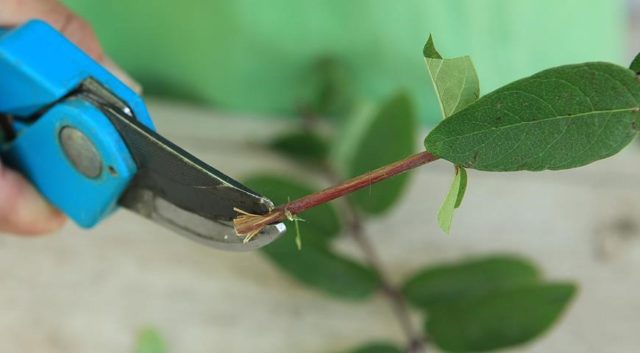
The plant is propagated mainly by vegetative methods.
The shrub is also propagated by seeds obtained from ripened fruits. However, this method of propagation is rarely used, since cultivation takes a long time, and varietal characteristics are often not preserved.
Diseases and pests
Long-fruited honeysuckle often suffers from powdery mildew, ramularia and European cancer. Fungal diseases can quickly destroy a plant, so at the first symptoms it is necessary to remove all affected shoots and treat the honeysuckle with copper sulfate and fungicidal preparations.
Among the pests that are dangerous for Longfruited are aphids, spider mites, gold beetles and red-legged stink bugs. When pests appear, it is recommended to treat the shrub with soapy water or special products, for example, Karbofos.
Conclusion
Description of the variety, photos and reviews of Long-fruited honeysuckle present it as a useful and easy-to-grow fruit plant. A special advantage of honeysuckle is its resistance to cold; in temperate climates, caring for the plant usually does not cause problems.
Reviews of Long-fruited honeysuckle

